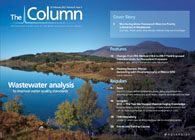Doping diagnosis
Banned substance use in sports still remains a controversial and highly publicized subject. A team of scientists from the Italian Sports Medicine Federation in Rome, Italy, has developed a screening procedure specifically designed for the detection of saccharides and polyalcohols in human urine, focusing specifically on dextran, hydroxyethyl starch and mannitol.

Banned substance use in sports still remains a controversial and highly publicized subject. A team of scientists from the Italian Sports Medicine Federation in Rome, Italy, has developed a screening procedure specifically designed for the detection of saccharides and polyalcohols in human urine, focusing specifically on dextran, hydroxyethyl starch and mannitol.1
With chromatographic conditions optimized, good linearity (R2 0.990–0.995), reproducibility of relative retention times (CV% lower than 1) and relative abundances of characteristic ion transitions (CV% lower than 10) were obtained. The lower limits of detection and quantification were in the range of 30–100 µg/mL.
The method was also used to establish a range of reference urinary concentrations and 600 doping control samples alongside 30 samples from volunteers not using any medication were examined.
The hydrolysis products isomaltose and maltose hydroxyl-ethylated, which were used as specific markers for the detection of dextran and hydroxyethyl starch, were not detected in urine. However, mannitol was present in all urines at a concentration range of 30–1200 µg/mL. As mannitol is present in other sources such as fruit, food and drug products, the results were less clear cut, however, the study concluded that this is a good starting point to fix a threshold value for doping control purposes.
1 Francesco Botrè et al, Drug Testing and Analysis, 3, 896–905 (2011).
This story originally appeared in The Column. Click here to view that issue.
LCGC Blog: Forensics Laboratories Underassess Uncertainty in Blood Alcohol Determinations
August 8th 2023The level of uncertainty provided by most forensic laboratories for reported blood alcohol results has been woefully underassessed. Not only is this bad science, but someone’s civil liberties may be at stake.







